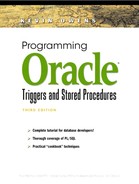11.16. Random Number Generation
You use the DBMS_RANDOM package to generate random numbers. You set the seed with the SEED function, which is overloaded.
PROCEDURE seed(val IN BINARY_INTEGER); PROCEDURE seed(val IN VARCHAR2);
Two methods for setting a seed are:
dbms_random.seed(123456); dbms_random.seed(TO_CHAR(SYSDATE,'dd-mon-yyyy hh24:mi:ss'),
The function VALUE generates a 38-digit precision number within the range:
0.0 <= value < 1.0
The function definition for a random number is:
FUNCTION value RETURN NUMBER;
The following block illustrates the VALUE function.
DECLARE
N NUMBER;
BEGIN
dbms_random.seed(123456);
N := dbms_random.value;
-- N will be a number similar to:
--
-- 0.92531681298113309873787795771931592618
END;
You can generate random numbers within a range. You call the function VALUE and pass the low and high limits. The function definition is:
FUNCTION value(low IN NUMBER, high IN NUMBER) RETURN NUMBER;
The random number returned is within the range:
low <= value < high
The following generates 10 random two-digit integer numbers.
BEGIN
dbms_random.seed
(TO_CHAR(SYSDATE,'dd-mon-yyyy hh24:mi:ss'));
FOR i in 1..10 LOOP
dbms_output.put_line(TRUNC(dbms_random.value(10,100)));
END LOOP;
END;
..................Content has been hidden....................
You can't read the all page of ebook, please click here login for view all page.
